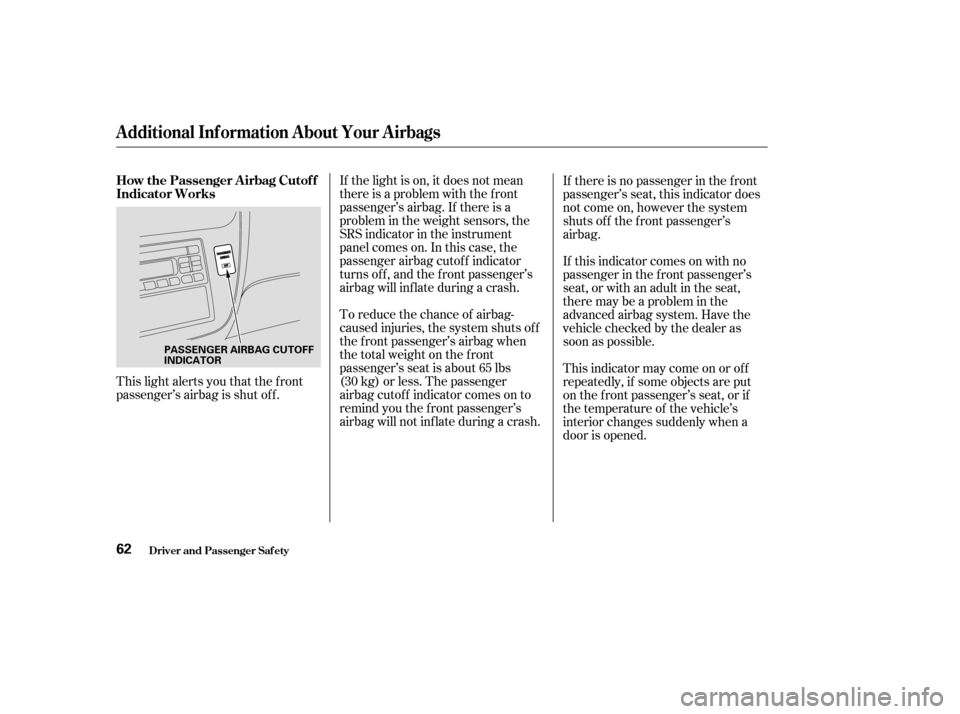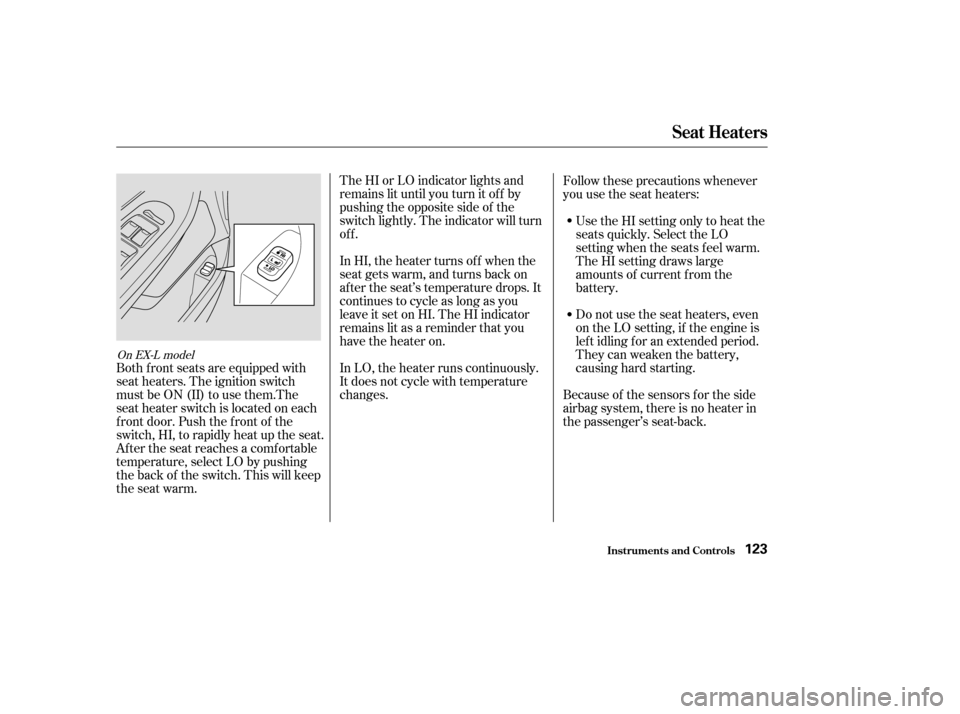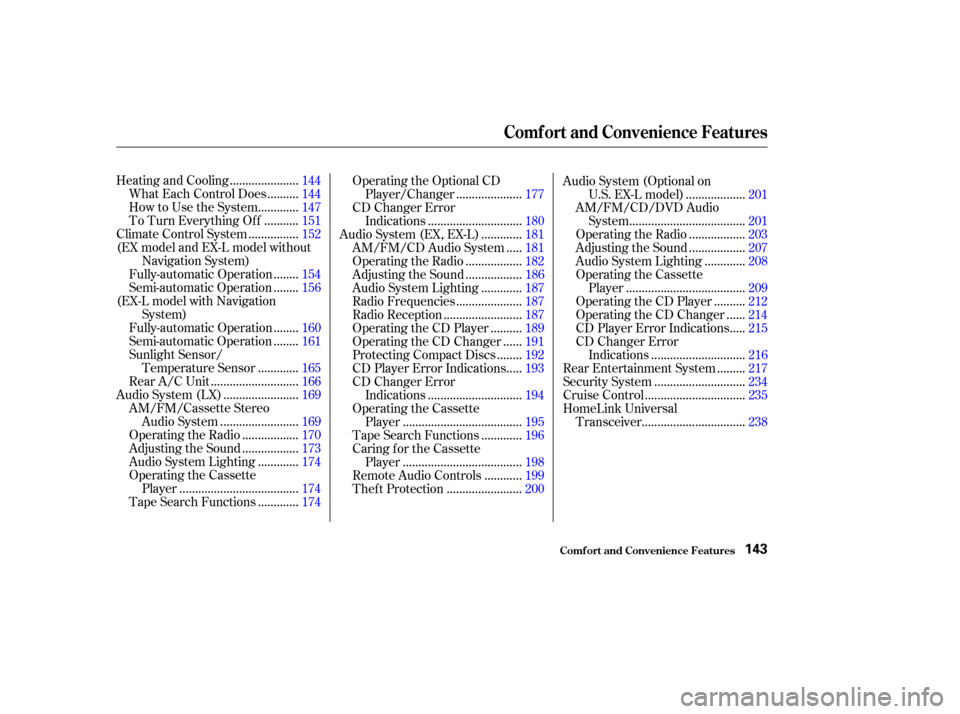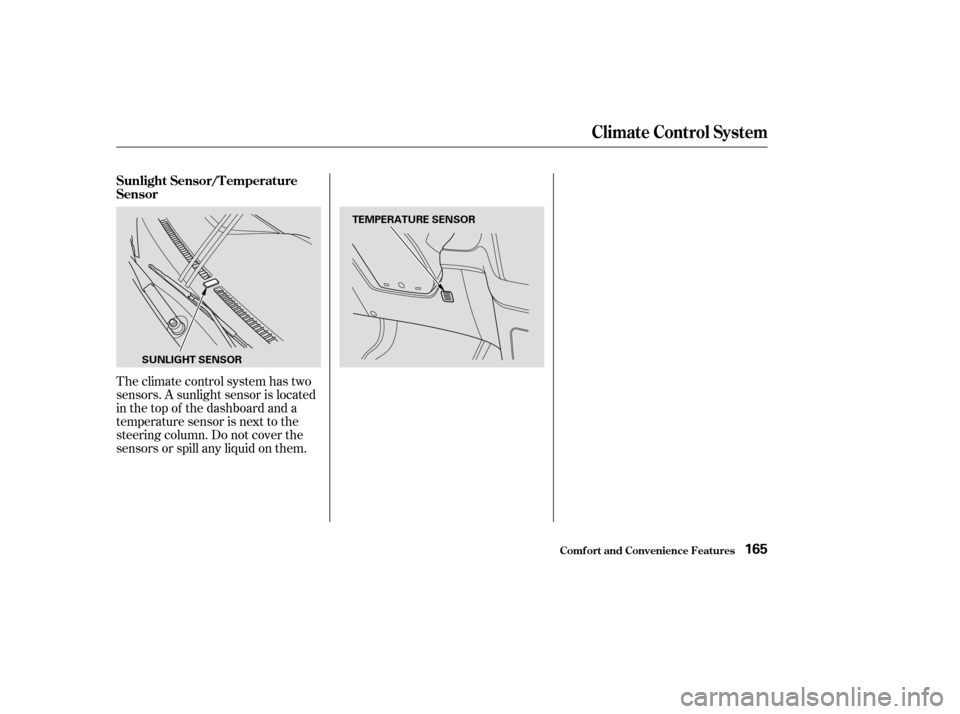sensor HONDA ODYSSEY 2003 RB1-RB2 / 3.G User Guide
[x] Cancel search | Manufacturer: HONDA, Model Year: 2003, Model line: ODYSSEY, Model: HONDA ODYSSEY 2003 RB1-RB2 / 3.GPages: 415, PDF Size: 5.28 MB
Page 65 of 415

This light alerts you that the f ront
passenger’s airbag is shut of f .If the light is on, it does not mean
there is a problem with the f ront
passenger’s airbag. If there is a
problem in the weight sensors, the
SRS indicator in the instrument
panel comes on. In this case, the
passenger airbag cutof f indicator
turns of f , and the f ront passenger’s
airbag will inflate during a crash.
To reduce the chance of airbag-
caused injuries, the system shuts of f
the f ront passenger’s airbag when
the total weight on the f ront
passenger’s seat is about 65 lbs
(30 kg) or less. The passenger
airbag cutoff indicator comes on to
remind you the f ront passenger’s
airbag will not inf late during a crash.If there is no passenger in the f ront
passenger’s seat, this indicator does
not come on, however the system
shuts of f the f ront passenger’s
airbag.
If this indicator comes on with no
passenger in the f ront passenger’s
seat,orwithanadultintheseat,
there may be a problem in the
advanced airbag system. Have the
vehicle checked by the dealer as
soon as possible.
This indicator may come on or of f
repeatedly, if some objects are put
on the f ront passenger’s seat, or if
the temperature of the vehicle’s
interior changes suddenly when a
door is opened.
Additional Inf ormation About Your Airbags
Driver and Passenger Saf ety
How the Passenger Airbag Cutof f
Indicator Works
62
PASSENGER AIRBAG CUTOFF
INDICATOR
Page 66 of 415

CONT INUED
To ensure the f ront passenger’s seat
weight sensors keep the passenger’s
airbag activated when an adult or
large child weighing about 65 lbs/
30 kg or more sits in the front
passenger’s seat, do not allow
anything to decrease the weight on
the seat. This includes, but is not
limited to, these examples:Front passenger’s seat f orcibly
moved backward into luggage or
other items placed behind it. Front passenger’s seat f orcibly
pushed up by luggage or other
items placed under it. Rear passengers pushing up the
frontpassenger’sseatwiththeir
f eet. If a passenger is tall enough to use
the seat belt and sit properly, but the
passenger airbag cutof f indicator
comes on and of f repeatedly, we
recommend that the passenger sits
in a rear seat. If the passenger must
sit on the f ront seat, move the seat
as far to the rear as possible, have
the passenger sit upright, and make
sure the seat belt is worn securely.
To ensure the f ront passenger’s seat
weight sensors keep the passenger’s
airbag deactivated when an infant or
small child weighing about 65 lbs/
30 kg or less sits in the f ront
passenger’s seat, do not allow
anything to increase the weight on
the seat. This includes, but is not
limited to, these examples:
Rear passengers pushing or
pulling the f ront passenger’s seat-
back or pushing the seat rails with
their f eet.
Heavy items placed in the f ront
passenger’s seat-back pocket.
Additional Inf ormation About Your Airbags
Driver and Passenger Saf ety63
Page 68 of 415

Together, airbags and
seat belts provide the best
protection.
Tampering could cause
the airbags to deploy, possibly
causing very serious injury.
If rain or spilled water
soaks into a seat-back, it can
prevent the side airbag system
f rom working properly.
This could make the
driver’s seat position sensor and
the f ront passenger’s weight
sensors inef f ective. Improperly
replacing or covering f ront seat-
back covers can prevent your side
airbags f rom inf lating during a
collision.
This could make the driver’s seat
position sensor and the f ront
passenger’s weight sensors
inef f ective. See page f or f urther inf ormation
and precautions relating to your
airbags.
first contact American
Honda at 800-999-1009. 252
Additional Saf ety Precautions
Donotattempttodeactivateyour
airbags.
Do not t amper wit h airbagcomponent s or wiring f or anyreason.
Do not expose t he f ront seat -backsto water.
Do not place any it ems under t hefront seats. Do not cover or replace f ront seat -
back covers wit hout consult ing aHonda dealer.
Do not modif y t he f ront seat s.If it is necessary t o modif y anadvanced f ront airbag syst em t oaccommodat e a person wit hdisabilities,
Additional Inf ormation About Your Airbags
Driver and Passenger Saf ety65
Page 76 of 415

This indicator lights when you turn
the ignition switch ON (II). It is a
reminder to you and your passengers
to protect yourselves by f astening
the seat belts. A beeper also sounds
if you have not fastened your seat
belt.
If you do not f asten your seat belt,
the beeper will stop af ter a f ew
seconds but the light stays on until
you do. Both the light and the beeper
stay of f if you f asten your seat belt
bef ore turning on the ignition.This indicator lights when you turn
the ignition switch ON (II). If it
comes on at any other time, it
indicates a potential problem with
your f ront airbags or automatic seat
belt tensioners. This light will also
alert you to a potential problem with
your side airbags, passenger’s side
airbag automatic cutoff system,
driver’s seat position sensor, or f ront
passenger’s weight sensors. For
complete inf ormation, see page .
This indicator lights when you turn
the ignition switch ON (II). If it
comes on at any other time, it
indicates that the passenger’s side
airbag has automatically shut off.
For complete inf ormation, see page
.
60
59
Indicator L ights
Inst rument s and Cont rols
Supplemental Restraint
System Indicator Side A irbag Cutof f
Indicator
Seat Belt Reminder L ight
73
Page 126 of 415

The HI or LO indicator lights and
remains lit until you turn it of f by
pushing the opposite side of the
switch lightly. The indicator will turn
off.
In HI, the heater turns of f when the
seat gets warm, and turns back on
after the seat’s temperature drops. It
continues to cycle as long as you
leave it set on HI. The HI indicator
remains lit as a reminder that you
have the heater on.
In LO, the heater runs continuously.
It does not cycle with temperature
changes.Do not use the seat heaters, even
on the LO setting, if the engine is
lef t idling f or an extended period.
They can weaken the battery,
causing hard starting. Use the HI setting only to heat the
seats quickly. Select the LO
setting when the seats f eel warm.
The HI setting draws large
amounts of current f rom the
battery.
Follow these precautions whenever
you use the seat heaters:
Because of the sensors f or the side
airbag system, there is no heater in
the passenger’s seat-back.
Both f ront seats are equipped with
seat heaters. The ignition switch
must be ON (II) to use them.The
seat heater switch is located on each
f ront door. Push the f ront of the
switch, HI, to rapidly heat up the seat.
After the seat reaches a comfortable
temperature, select LO by pushing
the back of the switch. This will keep
the seat warm.
On EX-L model
Seat Heaters
Inst rument s and Cont rols123
Page 146 of 415

.....................
Heating and Cooling .144
.........
What Each Control Does . 144
............
How to Use the System . 147
..........
To Turn Everything Of f . 151
...............
Climate Control System . 152
(EX model and EX-L model without Navigation System) .......
Fully-automatic Operation . 154
.......
Semi-automatic Operation . 156
(EX-L model with Navigation System) .......
Fully-automatic Operation . 160
.......
Semi-automatic Operation . 161
Sunlight Sensor/ ............
Temperature Sensor . 165
...........................
Rear A/C Unit .166
.......................
Audio System (LX) .169
AM/FM/Cassette Stereo ........................
Audio System .169
.................
Operating the Radio . 170
.................
Adjusting the Sound . 173
............
Audio System Lighting . 174
Operating the Cassette .....................................
Player .174
............
Tape Search Functions . 174Operating the Optional CD
....................
Player/Changer .177
CD Changer Error .............................
Indications .180
............
Audio System (EX, EX-L) . 181
....
AM/FM/CD Audio System . 181
.................
Operating the Radio . 182
.................
Adjusting the Sound . 186
............
Audio System Lighting . 187
....................
Radio Frequencies . 187
........................
Radio Reception .187
.........
Operating the CD Player . 189
.....
Operating the CD Changer . 191
.......
Protecting Compact Discs . 192
....
CD Player Error Indications . 193
CD Changer Error .............................
Indications .194
Operating the Cassette .....................................
Player .195
............
Tape Search Functions . 196
Caring f or the Cassette .....................................
Player .198
...........
Remote Audio Controls . 199
.......................
Thef t Protection .200 Audio System (Optional on
..................
U.S. EX-L model) . 201
AM/FM/CD/DVD Audio ....................................
System .201
.................
Operating the Radio . 203
.................
Adjusting the Sound . 207
............
Audio System Lighting . 208
Operating the Cassette .....................................
Player .209
.........
Operating the CD Player . 212
.....
Operating the CD Changer . 214
....
CD Player Error Indications . 215
CD Changer Error .............................
Indications .216
........
Rear Entertainment System . 217
............................
Security System .234
...............................
Cruise Control .235
HomeLink Universal ................................
Transceiver .238
Comf ort and Convenience Features
Comf ort and Convenience Feat ures143
Page 168 of 415

Theclimatecontrolsystemhastwo
sensors. A sunlight sensor is located
in the top of the dashboard and a
temperature sensor is next to the
steering column. Do not cover the
sensors or spill any liquid on them. Sunlight Sensor/T emperature
Sensor
Climat e Cont rol Syst em
Comf ort and Convenience Feat ures165
SUNLIGHT SENSORTEMPERATURE SENSOR
Page 255 of 415

Covering the outside edge of a
f ront seat-back, with a non-Honda
seat cover for example, could
prevent the airbag from inflating
properly.If a side airbag
inflates,acupholderorotherhard
object attached on or near the
door could be propelled inside the
vehicle and hurt someone.
This could make the driver’s seat
position sensor and the f ront
passenger’s weight sensors
inef f ective.
Some examples are:
Lowering the vehicle with an
aftermarket suspension kit that
signif icantly reduces ground
clearance can allow the
undercarriage to impact speed
bumps or other raised objects,
which could cause the airbags to
deploy.
Raising the vehicle with an
af termarket suspension kit can
af f ect the handling and stability.
Af termarket wheels, because they
are a universal design, can cause
excessive stress on suspension
components. Larger or smaller wheels and tires
can interf ere with the operation of
your vehicle’s anti-lock brakes and
other systems.
Do not modif y your steering wheel
or any other part of your
Supplemental Restraint System.
Modif ications could make the
system inef f ective.
Any object
attached to or placed on the covers
marked ‘‘SRS AIRBAG,’’ in the
center of the steering wheel and
on top of the dashboard, could
interf ere with the proper operation
of the airbags. Or, if the airbags
inf late, the objects could be
propelled inside the vehicle and
hurt someone.
If you plan to modif y your vehicle,
consult with your Honda dealer.
Removing parts f rom your vehicle,
or replacing components with non-
Honda (af termarket) components
could seriously af f ect your vehicle’s
handling, stability, and reliability. Modif ications
Additional Saf ety Precautions
A ccessories and Modif ications
Bef ore Driving
Do not place any object s over t heoutsideedgeof afront seat-back.
Do not at t ach hard object s on or
near a f ront door.
Do not modif y t he f ront seat s.
Do not at t ach or place object s on
the f ront airbag covers.
252
Page 352 of 415

Two f actors normally contribute to
causing corrosion in your vehicle:Moisture trapped in body cavities.
Dirtandroadsaltthatcollectsin
hollows on the underside of the
vehicle stays damp, promoting
corrosion in that area.
Removal of paint and protective
coatings f rom the exterior and
underside of the vehicle. Repair chips and scratches in the
paint as soon as you discover them.
Many corrosion-preventive measures
are built into your Honda. You can
help keep your vehicle f rom
corroding by perf orming some
simple periodic maintenance:
Inspect and clean out the drain
holes in the bottom of the doors
and body.
Check the f loor coverings f or
dampness. Carpeting and f loor
mats may remain damp f or a long
time, especially in winter. This
dampness can eventually cause
the f loor panels to corrode. Use a high-pressure spray to clean
the underside of your vehicle. This
is especially important in areas
that use road salt in winter. It is
also a good idea in humid climates
and areas subject to salt air. Be
caref ul of the ABS wheel sensors
and wiring at each wheel.
Have the corrosion-preventive
coatings on the underside of your
vehicle inspected and repaired
periodically.
1.
2.
Corrosion Prot ect ion
Appearance Care349
Page 394 of 415

If you are planning to take your
Honda outside the U.S. or Canada,
contact the tourist bureaus in the
areas you will be traveling in to f ind
out about the availability of unleaded
gasoline with the proper octane
rating.
If unleaded gasoline is not available,
be aware that using leaded gasoline
in your Honda will af f ect perf or-
mance and fuel mileage, and damage
its emissions controls. It will no
longer comply with U.S. and
Canadian emissions regulations, and
will be illegal to operate in North
America. To bring your vehicle back
into compliance will require the re-
placement of several components,
such as the oxygen sensors and the
three way catalytic converter. These
replacements are not covered under
warranty.
T echnical Inf ormation
Driving in Foreign Countries
391